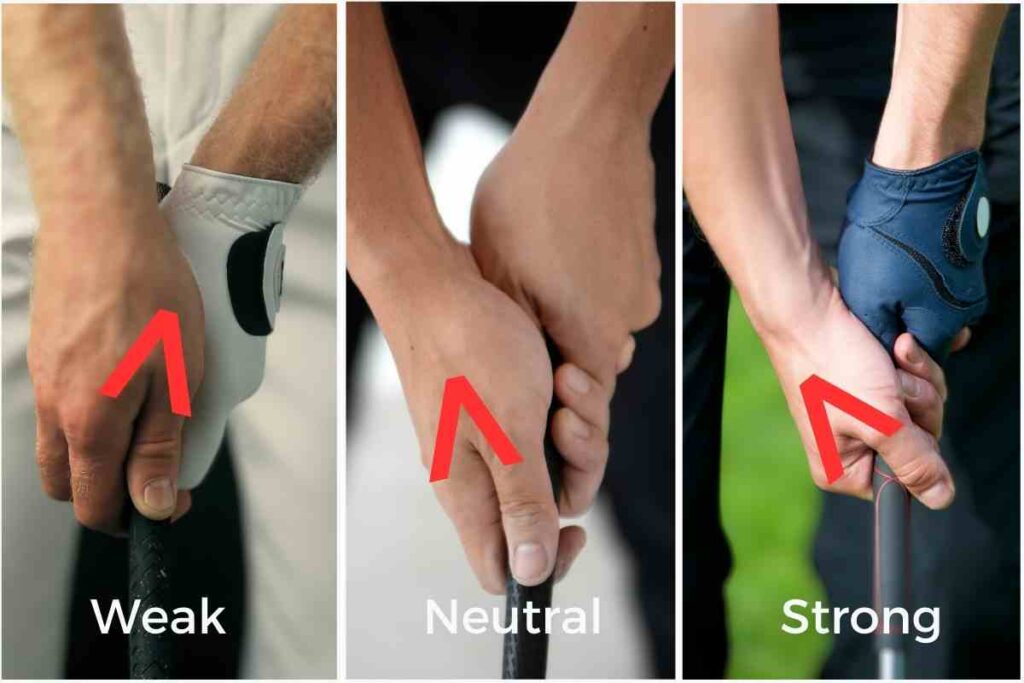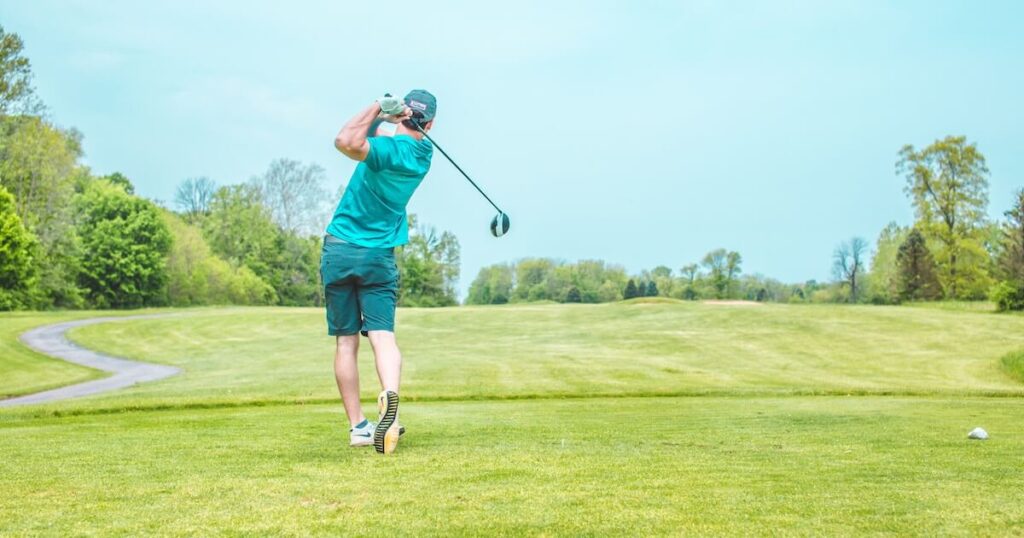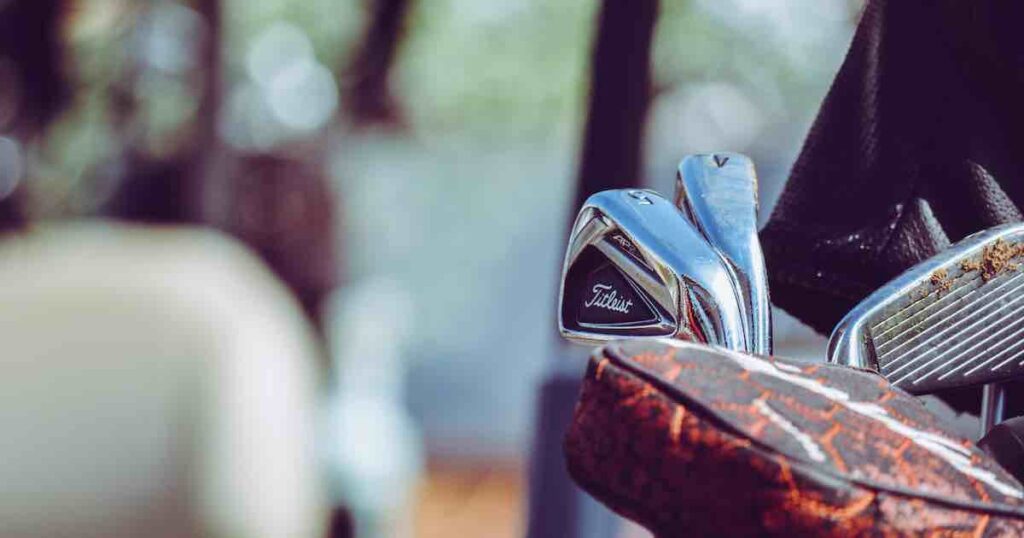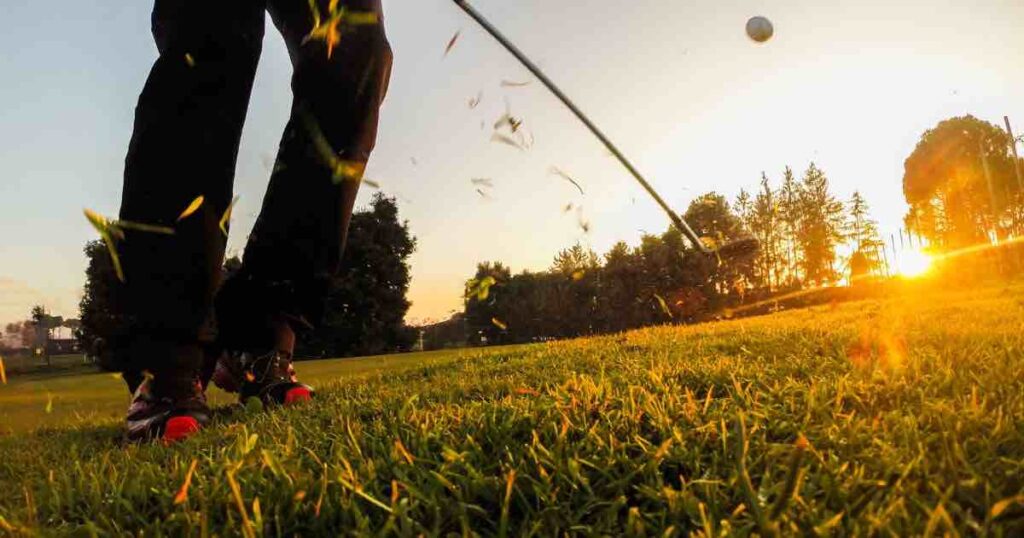Like most things in golf, the small details of how you hold a golf club can significantly impact the outcome of your swing. The way you place your hands on the club is a central starting point to successfully hitting the ball. A proper golf grip enables your accuracy, power, and consistency. This article will discuss why having a correct golf grip is essential. We will review how to grip a golf club properly and share some additional improvement tips.
Understanding the Types of Golf Grips
As mentioned, a proper golf grip can make all the difference in a golfer’s swing. But there isn’t just one golf grip. Three primary types of golf grips are most common: interlocking, overlapping, and baseball or ten-finger grip.

Interlocking Golf Grip
The interlocking grip is a popular golf grip used by many professional golfers, including Tiger Woods and Jack Nicklaus. It involves interlocking the right hand’s pinky finger with the left hand’s index finger. The benefits of using the interlocking grip include:
- Improved wrist action – The interlocking grip helps to lock the hands and wrists together, creating a more fluid swing.
- Increased grip strength – By interlocking the fingers, the grip becomes more secure, which can help prevent the club from slipping during the swing.
- Suitable for golfers with smaller hands – The interlocking grip allows golfers with smaller hands to achieve a solid grip on the club.
Overlapping Golf Grip
The overlapping grip is another popular one that many professional golfers use. The overlapping grip involves placing the right hand’s little finger over the left hand’s index finger. The advantages of using the overlapping grip include:
- Greater control – The overlapping grip allows for a tighter grip on the club, providing more control over the swing.
- More natural feel – Many golfers find the overlapping grip feels more natural than other grips.
- Suitable for golfers with larger hands – The overlapping grip is an excellent option for golfers with larger hands, as it allows for a more comfortable grip on the club.
Baseball or Ten-Finger Grip
The baseball or ten-finger grip involves placing all ten fingers on the club, similar to how one would grip a baseball bat. The benefits of using the baseball or ten-finger grip include:
- More control – With all ten fingers gripping the club, golfers can achieve a tighter grip, which provides more control over the swing.
- Suitable for beginners – The baseball or ten-finger grip is a suitable option for beginners just learning how to grip a golf club.
- Helps reduce slice – The grip can help reduce the severity of a slice as it allows for more control and a straighter swing path.
Finding the grip type that feels most comfortable and natural can take some time and experimentation. However, understanding the pros and cons of each grip type can help you make a more informed decision when detremining the best grip for your game. Whether using the interlocking, overlapping, or ten-finger grip, consistent practice and proper technique will help you build a solid foundation as you learn your golf swing.
How to Hold a Golf Club Step-by-Step
Now that we’ve covered the types of golf grips let’s dig into how to hold a golf club. Here are the steps to correctly hold a golf club using the overlapping grip:
Positioning the left hand (for right-handed golfers)
Start by positioning the clubface squarely behind the ball so the face is perpendicular to your target. The shaft should point roughly to your belt line, and your arm should hang straight down with your hand below your chin. Next, place your left hand on the club’s grip, ensuring that the club sits diagonally across your fingers into the palm of your left hand. The left thumb should be pointing straight down the club shaft, and you should have about an inch of the shaft poking out the bottom of your hand.
Positioning the Right Hand
With the left hand in position, bring your right hand up to the club, positioning it just below your left hand. The little finger of the right hand should overlap the gap between the index and middle fingers of your left hand. The right thumb should be placed on top of the left, creating a “V” shape pointing towards your right ear or shoulder.
Check Your Grip Strength
When it comes to golf grip strength, there are also three types: neutral, strong, and weak. A neutral grip is when the “V” formed between the thumb and forefinger of each hand points towards your right ear or shoulder (for right-handed golfers). When using a strong grip is the “V” points outside the right shoulder for right-handed golfers, and when using a weak grip the “V” points more toward the chest or left shoulder.

A strong grip can help golfers hit a draw but can also lead to hooking the ball. In contrast, a weak grip can lead to hitting a fade but can make it easier to hit a slice. With a neutral grip allows golfers can more easily hit both draws and fades. This is why a neutral grip is recommended for beginners since it will enable them to develop their swing without being limited by a particular ball flight pattern. This grip also promotes proper hand and wrist alignment, leading to better ball striking and increased accuracy. If you are new to golf, start with a neutral grip and develop your swing before experimenting with stronger or weaker grips.
This video from Paul Wilson Golf is a great overview of how to achieve a proper neutral golf grip on a golf club.
Check the Grip Pressure:
Once both hands are in position, you will want to check the grip pressure. A grip that is too tight can lead to tension and negatively impact your swing. On the other hand, a grip that is too loose can cause the club to slip or twist during the swing, resulting in errant shots. To check your pressure, hold your arms out with the club pointing to the sky and grip it as firmly as you can. This is a 10 out of 10 in terms of pressure. Then slowly release your grip until the club begins to slide down through your hands. This is a 1 out of 10. Ideally you want to be at a grip pressure of 4 out of 10.
Here is a great video from Golf Digest of Tom Watson talking about proper grip pressure:
Addressing the Ball
How you address the ball can have just as significant an impact on the outcome of your swing as how you grip a golf club. Here are some key factors to consider when addressing the ball:
Golf Stance and Posture
Maintaining a relaxed and neutral spine position in your golf stance is crucial to achieving proper posture and balance. A relaxed stance allows golfers to rotate their hips and shoulders more effectively, generating more power and accuracy in their swing. Additionally, a relaxed posture can help prevent back pain and injury.
Club Face Positioning
The clubface should be square to the ball, perpendicular to the target. This helps ensure the ball goes in the intended direction and reduces the likelihood of hook or slice shots.
Alignment
Proper alignment is critical for hitting accurate shots. Golfers should align their feet, hips, and shoulders parallel to the target line. This helps ensure the ball goes in the desired direction and reduces the likelihood of pushing or pulling shots.
Common Golf Grip Mistakes to Avoid
Unfortunately, it’s easy to make mistakes when finding the proper golf grip. Here are some common issues that you will want to avoid:
Gripping too tightly
One of the most common mistakes golfers make is gripping the club too tightly. A tight grip can inhibit wrist hinge, reducing the fluidity and power of the swing. Golfers should aim to hold the club with a firm but relaxed grip, allowing for a more natural swing and better shot control.
Incorrect placement
Another common mistake is placing the hands in the wrong position on the club. For example, holding the club entirely in the fingers or too deep into the palm of your left hand (for right-handed golfers) can lead to inconsistency in shots. Golfers should ensure that the shaft sits diagonally across the fingers into the palm of the left hand.
Wrong Grip Strength for Swing Speed
Some golfers use a grip that doesn’t match their swing, leading to off-target shots. For example, if you have a fast swing, a grip that is too weak may cause the clubface to open at impact, resulting in slices. On the other hand, if you have a slow swing, a grip that is too strong may cause the clubface to close at impact, which will cause you to pull or hook the ball. Finding a grip that matches your swing speed is essential for consistent and accurate shots, but it may take some time.
Avoiding these common golf grip mistakes can help with making solid contact out on the course. Practice getting a feel for proper grip technique until it feels like second nature, and seek guidance from a golf instructor if necessary.
Final Thoughts
As we’ve discussed, a proper grip is foundational to a successful golf swing. Consistent practice and patience are necessary to develop muscle memory and achieve a consistent grip that feels natural and comfortable. By following the steps for properly gripping a golf club, you can begin to improve your swing and achieve better, more consistent results.
Once you have learned how to hold a golf club, it’s crucial to maintain a relaxed grip and posture, position the clubface correctly, and align the body towards the target when addressing the ball. Collectively, these create a strong foundation for the golf swing, leading to better – and more enjoyable – performance on the course.




